

1. Broken News: Futbol News (Futbol Fever Increases, CR Team Readies Itself for the World Cup); Starbuck's is in Costa Rica to Stay; Nicaragua Pays the Tico Piper, Best Smelling Police in Costa Rica.
2. Rumble and Weather Talk: Fun on the Pacific Rim (Turrialba Gets Active Again, Similar Sized Earthquakes Happen in Two Different Areas)
3. Feature: Golden Gringo University: Understanding Costa Rican Culture (Part 3: Food & Markets, Music, Religion and Sports)
4. ¿Que Es Eso? Department: Strange Plant, Familiar Product
5. Feature: Family Vacation (and A Visit to a Vanilla Farm)
6. Health Stuff: Mad Mountain Bob Strikes Again (Watch Where You Go Hiking Dude)
7. What's-in-a-Word: Answer to Que Es Eso Mystery, Etymology of Casado
8. ROMEO Corner: de la Finca, Quepos
Wisdom of the Ages
|
Futbol News
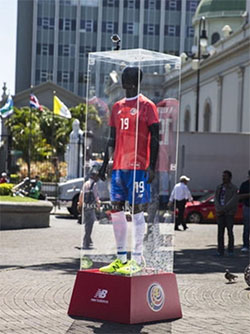 |
| New Sele Uniform on Display Outside the National Cathedral |
Futbol Fever Increases. With less than three months to go before the start for the FIFA World Cup Futbol Games in Russia (June 14), "Sele" fever is growing. The "Sele" or Selection Team is the Costa Rican national team that will participate in the games on behalf of the country and is composed of players from various teams internal to the country and/or those who play for a FIFA team elsewhere.
The basic requirement for a player to be on the selection team is that he be a citizen of the nation that the team represents. For example, Sele goalie Keylor Navas' full time job is as goalie for Real Madrid in Spain but he will be playing for Costa Rica in the World Cup. And one of Navas' teammates at RM is Christiano Rinaldo, a Portuguese dude who will be playing for his home country and possibly against Keylor at some point.
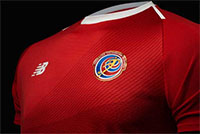 Adding to the growing enthusiasm, the Sele released the new uniform that will be worn by the players and which was made available to the public in late March. (the camiseta or t-shirt is shown at left). If you want to buy one, bring lots of colones as it's priced at only ₡55,900 or just about $100.
Adding to the growing enthusiasm, the Sele released the new uniform that will be worn by the players and which was made available to the public in late March. (the camiseta or t-shirt is shown at left). If you want to buy one, bring lots of colones as it's priced at only ₡55,900 or just about $100.
You can pick up your t-shirt at Importadora Monge, a chain of 126 stores all over Costa Rica (there's even one in Quepos). You can also get it on credit at ₡2,940 per month (24 months?).
World Cup Football Season is definitely here amigos.
 |
| The Fans Are Ready |
Costa Rica Prepares for World Cup. Now that Costa Rica has assured itself of a berth in the upcoming World Cup games in Russia the Ticos are starting to prepare for the contest. The games begin on Thursday, June 14 and run through Sunday, July 15. How's that for a grueling schedule if you're lucky enough to make it all the way to the cup.
 |
| Ticos vs Scots |
To get in shape, Costa Rica, like most teams, scheduled several international warm-up games during March. One of the games they played was against Scotland in Scotland and the Tico Sele team squeaked out a 1-0 win (aye, put that in your bonnet, laddies). One of the heroes of the game, as usual, was Keylor Navas, the goalie and Costa Rica's most famous player. He shut out the Scots - this dude ran a 91% on-goal save rate in the last world cup.
Unfortunately, on March 27 Mr. Navas couldn't shut out the Tunesians who surprised the Ticos with a 1-0 win in Nice, France. So the Ticos remain 1-1 in pre-cup qualifiers.
In addition to valuable practice together as a national selection team (remember these players normally play for a variety of other teams inside or outside Costa Rica), the March games will be an opportunity for evaluating the readiness of several Sele players who have had recent injuries.
The one player they don't worry about is portero (goalkeeper) Keylor Navas who is in great shape, at least at the moment, and is roaring to go.
Starbuck's is in Costa Rica to Stay
"Today, Starbuck's has more than 740 stores across 13 countries within the region and has served more than 100 million Latin American customers in 2013." So says a recent press release from the company.
I saw a report a couple of years ago that said Starbuck's obtains more than 40% of it's worldwide bean requirement from Ticoland. As a result, they have made and are continuing to make, substantial investments here. A recent example is the new visitor's center at their main coffee farm (photo below, left).
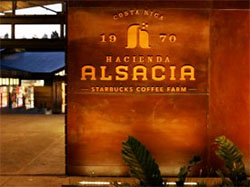 Called Hacienda Alsacia, it is located on the 600 acre farm on the slopes of Volcan Poas and has been in operation since 1970 as the welcoming sign shows. A brand new visitors center has been opened recently at which "...visitors will have the chance to experience coffee from seed to cup and see firsthand the agronomy work the company has been supporting and investing in for more than two decades.
Called Hacienda Alsacia, it is located on the 600 acre farm on the slopes of Volcan Poas and has been in operation since 1970 as the welcoming sign shows. A brand new visitors center has been opened recently at which "...visitors will have the chance to experience coffee from seed to cup and see firsthand the agronomy work the company has been supporting and investing in for more than two decades.
The agronomy and community development efforts that Starbuck's performs include:
Impressive; and damn, I do like that strong dark version of Costa Rica coffee that Starbuck's purveys..
Nicaragua Pays the Tico Piper
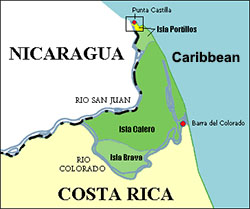 The Golden Gringo Chronicles has followed the story of Nicaragua's incursion into the northeast corner of Costa Rica that occurred in 2010. It took nearly eight years to work the complaint through the World Court in Costa Rica's favor. The court ordered Nicaragua first to cease and desist development of what was likely to be a new major port for our northerly neighbors, then to withdraw their troops from Isla Calero, the island they invaded, and then to pay damages to Costa Rica to cover their environmental losses and extra expenses incurred.
The Golden Gringo Chronicles has followed the story of Nicaragua's incursion into the northeast corner of Costa Rica that occurred in 2010. It took nearly eight years to work the complaint through the World Court in Costa Rica's favor. The court ordered Nicaragua first to cease and desist development of what was likely to be a new major port for our northerly neighbors, then to withdraw their troops from Isla Calero, the island they invaded, and then to pay damages to Costa Rica to cover their environmental losses and extra expenses incurred.
To their credit, Nicaragua withdrew their troops a few months ago and, just this past month, paid assessed fines to Costa Rica of $380,000. In addition, the court confirmed the disputed border that had been established in the 1800's and also confirmed the Tico ownership of certain oil fiends in the Caribbean that Nicaragua attempted to claim.
Let's hope this is the final end to an unpleasant part of neighborhood history.
Best Smelling Police in Costa Rica
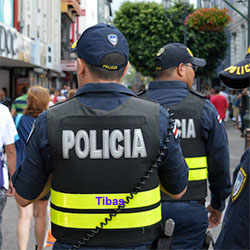 |
| No B.O. in Tibás |
Tibás is a barrio on the north side of San José, most notably known for housing the home stadium (Estadio Ricardo Saprissa Aymá) for Saprissa, one of the top futbol teams in Costa Rica. GG fancies himself a Saprissista (that's because I know their fight song).
A recent press report announced that three police officers from the local public force barracks were arrested for what amounts to corruption; they failed to turn in confiscated property. The property? Some 300 cans of personal deodorant. GG suspected there was something that smelled bad in this story.
Maybe they should send a few cans down to the Quepos barracks where it's much hotter and our cops tend to sweat more. Just a thought amigos.
¡Pura Vida!


 GGC Publications Group is the parent organization that publishes the Golden Gringo Chronicles as well as a number of books and paraphernalia related to the Chronicles and Costa Rica.
GGC Publications Group is the parent organization that publishes the Golden Gringo Chronicles as well as a number of books and paraphernalia related to the Chronicles and Costa Rica. The page is called GGC Publications Page - Products and has 3 sections:

 This section of the GGC Publications Page consists of descriptions of the following books published by GGC Publications:
This section of the GGC Publications Page consists of descriptions of the following books published by GGC Publications:Or go here for all of them: GGC Publications Page - Products Section I
Section II: Recommended Inspirational Books - Life Changing Stories

 S.O.B.E.R. - How the Acronyms of AA Got One Drunk Sober - by Ian Asotte (description and details HERE)
S.O.B.E.R. - How the Acronyms of AA Got One Drunk Sober - by Ian Asotte (description and details HERE)
◄To Eternal Happiness - by Abelardo Garcia, Jr. (see description and details HERE)
A Woman Awakens: Life, AfterLife - by Jan Hart (see description HERE)►
Or go here to see all of them: GGC Publications Page - Products Section II
Section III: T-Shirts and Coffee Mugs All About Costa Rica and the Chronicles
In addition, GGC Publications Group now also offers t-shirts and coffee mugs that are related to the Golden Gringo Chronicles with Costa Rican themes, to wit:

 T-Shirts: a. Golden Gringo Chronicles with Logo, b. Official Golden Gringo with Monkey on Banana Hammock, c. ¡Quepo en Quepos! ("I Fit In Quepos!") with Photo of Quepos, d. Wanna Monkey Around - Come on Down! with Photo of White Face Monkey and e. It's OK to be Slothful with photo of Three-Toed Sloth.
T-Shirts: a. Golden Gringo Chronicles with Logo, b. Official Golden Gringo with Monkey on Banana Hammock, c. ¡Quepo en Quepos! ("I Fit In Quepos!") with Photo of Quepos, d. Wanna Monkey Around - Come on Down! with Photo of White Face Monkey and e. It's OK to be Slothful with photo of Three-Toed Sloth.
Coffee Mugs: a. Golden Gringo, b. Wanna Monkey Around?, c. OK to be Slothful
Fun on the Pacific Rim
March saw the return of fairly sizable and remarkable Pacific Rim activity in Costa Rica.
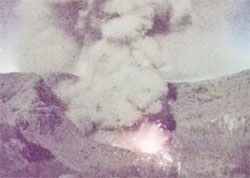 On March 7 volcano Turrialba, which has demonstrated on and off activity over the past three years, came alive again throwing out volumes of gases, ashes and incandescent fragments of fresh lava. The plumes reached 1,000 meters (about two-thirds of a mile) above the crater.
On March 7 volcano Turrialba, which has demonstrated on and off activity over the past three years, came alive again throwing out volumes of gases, ashes and incandescent fragments of fresh lava. The plumes reached 1,000 meters (about two-thirds of a mile) above the crater.
Prevailing winds carried ash material to the southwest and several communities in the metropolitan area (Cartago, Alajuela, Heredia, San Jose) reported ash-fall. Health authorities in Costa Rica recommended preventive measures including the use of artificial tears, wet towels, long sleeve shirts and, in extreme cases, a surgical mask. Other than the potential health risk due to ash, none of the volcano output threatened nearby population but it did make quite a show and in at least one case was accompanied by a modest tremor.
On March 12, the Red Seismological Nacional (RSN) – National Seismological Network reported a 5.0 tremor occurring near Parrita, 45 km north of Quepos at about 3:40 in the afternoon. Friends that I know reported feeling it, GG did not (might have been my nap time).
On March 23 at about 1:40 in the morning we had another tremor that was labeled as a magnitude 4.8 by the UCR Red and 5.5 by the United States Geological Survey, this one only 15 miles to the northeast of us. The depth reported was 36 km (22 miles). GG was awakened by the bed roll which lasted about 5 seconds but thoroughly shook the building. It was kind of like being in the old vibrating beds at the Holiday Inn (remember those, amigos?).
Check Out Recent Earthquakes Around the World Posted by the U.S. Geodetic Survey: Recent Quakes |
Search the Golden Gringo Chronicles Archives for Topics That Interest You
You can use our Archives to search for anything that has been written in more than 220 feature articles of the Golden Gringo Chronicles plus find Broken News items and ROMEO restaurant reviews. Enter your topic or item to search in the Google Search Routine below and follow the links offered from the search results. Suggestion: Enter only a simple, precise and unique as possible keyword or two in order to narrow the number of references retrieved:
Readers: Our publication is open to suggestions regarding future articles and will accept pieces written by others but we reserve the right to decline anything that the editorial staff (that's GG) thinks is inappropriate for this format. Send proposals, comments, suggestions, ideas, meaningless statements and jocular observations concerning the Chronicles to GG here: gg@goldengringo.com.
 The idea behind Golden Gringo University is to present educational topics of wide interest to expats who have recently moved to Costa Rica, or to future expats who might be thinking of moving here, or to those who simply visit here frequently.
The idea behind Golden Gringo University is to present educational topics of wide interest to expats who have recently moved to Costa Rica, or to future expats who might be thinking of moving here, or to those who simply visit here frequently.
Our goal and objective is to provide accurate information that readers will find helpful in their efforts to be a good expat resident or visitor in Costa Rica.
To see Parts 1and 2 of this three part series go here:
Part 1: History of Costa Rica, Physical Size and Population, the Costa Rican Constitution, Government Structure and Stability and the Economy.
Part 2: Language and Education, Money and Banking, Names and Surnames, Addresses & Street Names.
To see other topics recently covered by GGU, go here: GGU Archive.
This month in Part 3 we discuss: Food & Markets, Music, Religion and Sports.
Food and Markets
The cuisine of Costa Rica basically derives from a peasant culture. GG often refers to local cuisine as "peasant cuisine" and I mean that in the best positive sense. It's the kind of food that will sustain people who work hard physically. It is locally and easily grown in a favorable climate in rich soils that yield a myriad of vegetables and fruits. That means it is readily available and relatively inexpensive. It also happens to be tasty and chock full of energy and nutrients. Haute cuisine it isn't, mais pour que nous avons Paris, non ? (GG's just faking it for our Quebec friends)
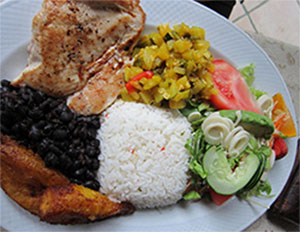 |
| A Typical Casado |
Probably the most common type of meal in Costa Rica is the venerable "casado" (see What's-in-a-Word section below for the etymology of this word). A casado (photo at left) is typically a complete meal served on a plate or small platter.
A casado will usually include a small piece of fried fish or pork such as a pork chop (shown) or chicken or maybe carne in salsa (beef in sauce almost like beef stew but without the vegetables) or chicken in sauce. Inevitably the plate will include black beans and rice or gallo pinto. Gallo pinto is rice and beans cooked together with some flavoring and a bit of minced vegetables such as sweet pepper and onion.
A casado will also likely have a small salad right on the plate as well as a third starch such as yucca, diced squash or macaroni shells. The platter often will also have fried ripe sweet plantains known as "maduros". Occasionally the whole thing may be topped by a fried egg or halved hard-boiled eggs and the platter may be rounded out with a few pieces of bread or or a couple of plain tortillas. The high carbohydrate in this meal content is perfect for sustaining a farm worker through an arduous day in the field but is more than necessary for the modern office worker and may be a contributory factor to the burgeoning obesity problem here. To read more on the growing obesity problem, go HERE.
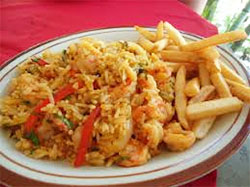 |
| Arroz con Camarones (Shrimp), Who Says You Can't Serve French Fries with Rice |
Another favorite standard is combining rice, prepared similarly to Asian fried rice, with various meats and seafoods; something GG calls arroz con something. That something may be pieces pork, chicken, beef, shrimp, mixed seafood or seafood mixed with pieces of meat and vegetables, that latter version often called arroz cantonese. There are many restaurants called "sodas" which are usually small in seating capacity, often employ the word "Tipico" in their restaurant signage and which offer their version of casados and arroz con something. A "tipico" Costa Rican restaurant would not be so if it did not have these two food family groups on the menu.
In addition to the casado and rice dishes mentioned above, Costa Rican "tipico" restaurants will offer a smattering of Mexican or Latin American style dishes such as tacos, quesadillas, chalupas, burritos etc. One interesting thing about Costa Rican cuisine is that most dishes are not heavily spiced (GG's stomach thanks you for that). But in most Tico restaurants the table will have a large container of uncooked vegetables such as carrot and onion slices swimming in a strongly jalepeno-spiked liquid to add to the casado. This is for those people that must have heat with their flavor.
At this moment in history, supermarkets, as thought of in North America, exist side by side with what would be considered in the north as corner grocery stores. In recent decades the supermarket concept has grown considerably here both as locally owned markets as well as being spurred by large chains moving in from other countries including the U.S. As an example, Walmart now owns the Pali and Maxi-Pali chains and has markets under its own corporate name in the central valley. In Quepos we have a Pali, a Maxi-Pali and, more recently a BM Supermarket, a Spanish based supermarket chain. Yet many corner grocery stores still exist either through loyalty or convenience. The small and medium sized ones still call themselves "Super Mercados" and the really small ones may operate as Mini-Supers or, like one in GG's neighborhood, a Mini Bodeguita which is a diminutive on the diminutive bodega.
Besides the fixed-wall markets there are temporary fresh markets or farmers markets called "ferias" in most towns which operate from 2-6 days per week depending on the size of the town. At the feria you can find a myriad of local and some imported fruits and vegetables. GG spent much of his first two years here discovering a new fruit or vegetable every month at the local feria and learning the nutritional and health value of many. For more information on markets go here:
Quepos Markets Growing: Super Expansion Fever
Malecon: Edition 88 - Dam Good Life
Fresh Market I: Edition 16 - La Feria de Quepos
Fresh Market II: Edition 39 - La Feria de Quepos
More on Fruits: Pick a Fruit
Music
Travel around Costa Rica and you will encounter a strong sense and love of many kinds of music. Teenagers, like in most places, love rock in most of its forms and even rap, often in a Latin form.
But by far the most common and typical music is classical Latin expressionism. The older crowds tend to enjoy: Merengue, Salsa, Soca, Cumbia, Rumba, Bachata, Classical and Tex-Mex. A Latin rhythm, loud and upbeat, is heard almost everywhere including any store that happens to be having a sale (promoción) at the moment.
Holidays cause Ticos to burst out in song and Latin music. They have found many expressions of their local culture in music. As an example of a native folk song, check this out: Soy Tico.
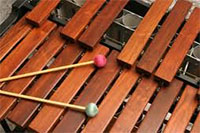 Tico music tends to shy away from strong horns like in Mexican music but they love guitars and combinations of wind and percussion instruments. One instrument that often appears in public places at holidays and special events is the marimba, kind of a wooden xylophone that originated in the Caribbean and which in recent years was designated as the Costa Rican National Instrument. To see more about this instrument, go HERE.
Tico music tends to shy away from strong horns like in Mexican music but they love guitars and combinations of wind and percussion instruments. One instrument that often appears in public places at holidays and special events is the marimba, kind of a wooden xylophone that originated in the Caribbean and which in recent years was designated as the Costa Rican National Instrument. To see more about this instrument, go HERE.
Speaking of Caribbean, there is a very strong calypso music influence on the east coast of Costa Rica as a result of extensive migration, voluntary and involuntary, from Jamaica and Trinidad over the last 200 years. Calypso music came with the migrants. According to a good friend who came from the Tortugeuro area, and whose family is of Jamaican origin, original calypso came to the Caribbean in African languages which were first translated to English and eventually to Spanish. To read more on the calypso spirit go HERE.
You can also enjoy international classical music performances in the central valley, particularly the Costa Rican Symphony at the Teatro Nacional theatre in San José and elsewhere.
Music is the lifeblood of Tico culture.
Religion
The predominant religion here is Roman Catholicism. It not only is the most common religion but it also happens to be, at least for the moment, the official state religion as designated in the constitution. There is a movement afoot to drop that designation from the constitution. The current presidential runoff election reflects the current debate as it is a contest between an evangelical preacher (Fabricio Alvarado) and a more secularist oriented contender (Carlos Alvarado). Although they share the same last name they are not relatives and about the only thing these two have in common belief is being Tico and having a democratic form of government.
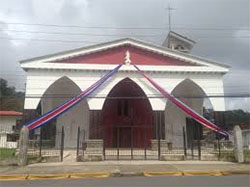 |
| Quepos Catholic Church |
What being a state religion has meant above all is that a significant amount of aid went into the growth of the church's physical plant at government expense. One of the early things GG learned living in Quepos (from my Spanish teacher) was that the Catholic Church in Quepos was originally built by MOPT (Ministerio de Obras Publicas y Transportes), the Costa Rican state version of a department of transportation. My teacher knew this because his grandfather was the chief engineer for MOPT on the project.
The good news is that, despite having a state religion, there are virtually no restrictions or impediments placed on the practice of other faiths here. GG has seen this in practice. Take for example that within a two-block radius of my apartment in little Quepos there is a prospering Luz del Mundo church, an active Kingdom Hall of Jehovah's Witnesses and one other undefined sect that meets in a small private hall nearby. There are also several evangelical churches about town and many across Costa Rica.
Freedom of religious expression is alive and well in Costa Rica.
Sports
What can I say, it's all about futbol. Gringos and other Norteamericanos call it soccer. There are many local futbol teams in the national confederation including some long-time rivalries in the central valley such as La Liga (Alejuela), Club Herediano (Heredia) and Saprissa (San José) who generate great enthusiasm for the game among the general populace here.
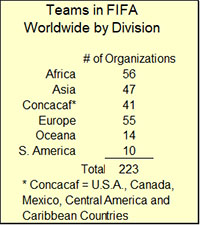 But futbol goes far beyond country borders and is truly an international sport. There are some 233 futbol associations around the world on six continents as shown in the table to the left. The world organization that oversees the competition of these is the FIFA (Fédération Internationale de Football Association) or the International Federation of Association Football in English. FIFA establishes and monitors the progression of association teams to qualify for the quadrennial World Cup games. Costa Rica has been a member of FIFA for many years.
But futbol goes far beyond country borders and is truly an international sport. There are some 233 futbol associations around the world on six continents as shown in the table to the left. The world organization that oversees the competition of these is the FIFA (Fédération Internationale de Football Association) or the International Federation of Association Football in English. FIFA establishes and monitors the progression of association teams to qualify for the quadrennial World Cup games. Costa Rica has been a member of FIFA for many years.
Depending on the size and population of the country, it may have more than one futbol association and a quite a few teams. In Costa Rica, which is part of the CONCACAF Division (as is the U.S.) there is one national futbol association.
 Early in the quadrennial cycle a "sele" team will emerge from each country by appointment and eventually the top 32 national selections, by virtue of playoffs, will qualify and compete for the World Cup. The only FIFA requirement for any sele team is that a member must be a citizen, by birth or naturalization, of the country he is representing. This year, 2018, is a World Cup year and the games will take place for about five weeks from mid-June to mid-July. The venue for the games this year is Russia.
Early in the quadrennial cycle a "sele" team will emerge from each country by appointment and eventually the top 32 national selections, by virtue of playoffs, will qualify and compete for the World Cup. The only FIFA requirement for any sele team is that a member must be a citizen, by birth or naturalization, of the country he is representing. This year, 2018, is a World Cup year and the games will take place for about five weeks from mid-June to mid-July. The venue for the games this year is Russia.
Other sports are practiced in Costa Rica including baseball and basketball but they are muted in intensity compared to futbol. There even is a fledgling ice hockey team (if Jamaica can have a bob-sled team, Costa Rica can have a hockey team) that was founded and funded by a couple of Canadians; it practices in an indoor rink near Heredia.
There is, of course, always surfing competition, both regional and international, in a country with endless beaches and strong surf. Costa Rica has been the site of a number of world organization surfing meets and its best surfers have grabbed their share of medals and awards in this sport, which is natural to many Ticos.
___ ___ ___
This completes part three of Golden Gringo University's discussion on Understanding Costa Rica Culture Better. If any of our readers would like to suggest an area of helpful discussion for the GG University format simply contact GG at gg@goldengringo.com.
¡Solo Bueno!
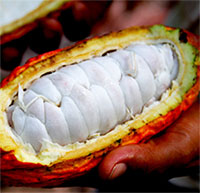
What could that be? Looks like eggs inside a plant.
Could something edible actually come from that?
Or maybe it will be chicks of some type?
Answer in What's-in-a-Word section below.
¡Solo Bueno!
 |
| GG, Jenny and Dale on the Trail |
At the end of February and early March, GG was gifted with a week-long visit from his oldest daughter Jennifer and her boyfriend Dale who currently live in the Lehigh Valley of Pennsylvania. Both work as IT professionals for a major energy company there and this visit was about grabbing some well needed vacation time.
This was Jen's second visit and Dale's first and they were both anxious to see as much of Costa Rica as they could.
That they did, scheduling six tours over a five day period. One of the tours was to a vanilla farm called Villa Vanilla, about ten miles east of Quepos. GG had hoped to take this tour as I hadn't been on it before but elected to stay home nursing a wound I got on an earlier tour (GG's days of hiking mountain trails are definitely numbered amigos).
So I asked Jen and Dale to write a report on their experience at the vanilla farm and what follows is their rendition. I should point out that Jen is an amateur photog and takes prolific numbers of high quality photos; all of those below are hers. Here's how they put it:
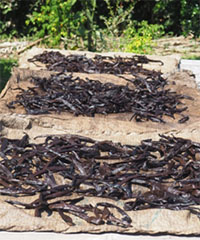 |
| Vanilla Beans Drying |
"Our trip to Costa Rica was one of wonder, adventure, and even some minor misadventures. We had a wonderful week of seeing and engaging in new experiences. While we were afforded some awe-inspiring sunsets, vistas, nature hikes, and boat tours I would have to say that our visit to Villa Vanilla was one of the most interesting tours we undertook during our trip. We came very close to cutting this excursion from our itinerary and that would have been regretful.
We took the morning tour and were fortunate enough to see the vanilla beans laid out on the tables undergoing their morning sun bath before they were collected and stored for the day. This is part of their daily three to four month conditioning process. We would soon learn the importance of this process.
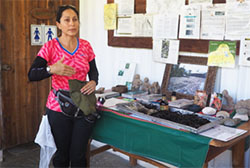 After we were all gathered, Giselle (left) began the tour by teaching us about the vanilla orchid and the process it needs to go through in order to mature into a viable vanilla bean. It’s a fascinating process and we now understand why vanilla is such a pricey spice.
After we were all gathered, Giselle (left) began the tour by teaching us about the vanilla orchid and the process it needs to go through in order to mature into a viable vanilla bean. It’s a fascinating process and we now understand why vanilla is such a pricey spice.
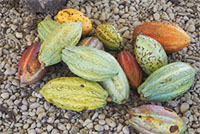 After the vanilla bean, we were educated on cacao and cinnamon. The information about these spices is equally as fascinating and informative as the vanilla bean. As an added bonus, all of the explanations came with some product tastings.
After the vanilla bean, we were educated on cacao and cinnamon. The information about these spices is equally as fascinating and informative as the vanilla bean. As an added bonus, all of the explanations came with some product tastings.
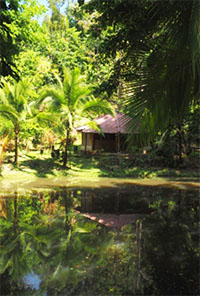 |
| Villa Vanilla Lodge |
We spent about 30 minutes learning about the three main spices: vanilla, cacao, and cinnamon before touring the farm. As we meandered our way through the grounds, we were treated to some beautiful landscaping and able to observe many additional spices, fruits, and flowers growing throughout the property. Beyond the cacao pods and vanilla orchids, we saw coffee pods, bananas, star fruit, and additional orchid varieties to name a few.
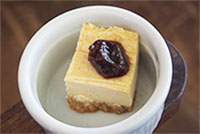 The tour of the grounds came to a respite at a beautiful lodge that overlooked the Costa Rican mountains where we were able to indulge in a number of treats that used the products of the farm: Ceylon cinnamon tea, cheesecake, brownie with ice cream, hot cocoa, and a cookie. Yum! Yum! Yummy!
The tour of the grounds came to a respite at a beautiful lodge that overlooked the Costa Rican mountains where we were able to indulge in a number of treats that used the products of the farm: Ceylon cinnamon tea, cheesecake, brownie with ice cream, hot cocoa, and a cookie. Yum! Yum! Yummy!
The tour wrapped up at the spice shoppe where we had the opportunity to purchase the vanilla beans and additional spices that they happened to have in stock. Needless to say, we have been enjoying our purchases back here at home.
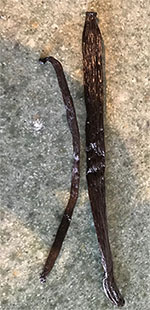 |
| U.S. vs V.V. Beans |
The whole experience was wonderful. The grounds are beautiful and the tour is both educational, and delicious. I think what we liked best was that the produce is organic, sustainable, and notably superior in flavor and appearance to the mass produced spices we have back at home. Note the difference in the picture to the right of the organic vanilla bean from Villa Vanilla (on the right) versus the organic vanilla bean purchased in a US supermarket (on the left).
To circle back around and answer some logistical questions for you… We scheduled the tour 3 days in advance and didn’t have any trouble getting the reservation. The farm sent a van to pick us up at our resort. We were told to be ready for an 8:30 am pickup time, but it was closer to 9:00 until the van arrived. However, we had been warned about this, so weren’t surprised. We think they just tell everyone 8:30 and then make their rounds to pick up whomever they need to pick up. But the van was comfortable and the driver drove very respectfully.
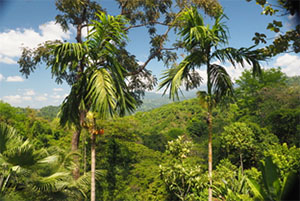 The drive to the farm is interesting in and of itself as you go through some of the more local neighborhoods and can observe the more traditional landscape. It took about 40 minutes for us to get from Manuel Antonio to Villa Vanilla. We would say the tour is suitable for most ages and physical ability. You do need to climb some stairs to reach the food tasting portion of the tour, but there are handrails to use.
The drive to the farm is interesting in and of itself as you go through some of the more local neighborhoods and can observe the more traditional landscape. It took about 40 minutes for us to get from Manuel Antonio to Villa Vanilla. We would say the tour is suitable for most ages and physical ability. You do need to climb some stairs to reach the food tasting portion of the tour, but there are handrails to use.
The tour, with transportation, cost $50 USD and the fee was paid at the end of the tour at the spice shoppe. That way they were able to collect all the money at a single time. Colones and dollars are both accepted. It is important to note that it is a cash only facility.
If you have the opportunity, please take the time to visit Villa Vanilla. It’s a half day adventure that is well worth the time spent. We may have gone on and seen more thrilling Costa Rican adventures, but as food (and dessert) lovers, we found this particular excursion to be fun, beautiful, educational, and just a little bit different from the rest of the trip.
We hope if you get the chance to visit Villa Vanilla you enjoy it as much as we did."
Thanks Jen and Dale for a great report. On the strength of that write-up, ol' Dad is now obligated to visit and tour Villa Vanilla. Come back soon kids, there's oh so much more Costa Rica to see.
¡Pura Vida!
Health Stuff
Mad Mountain Bob Strikes Again
(Watch Where You Go Hiking Dude)
| Note: The information given in this section is offered as news information only and does not indicate GGC confirmation or denial of the accuracy of the treatment or a recommendation to pursue it, nor can we or do we guarantee the efficacy of the results nor validity of the conclusions proffered. (How's that for a disclaimer?) |
In the article on the vanilla farm above GG mentioned he had experienced an accident on a tour with Jen and Dale. This particular excursion took place in the mountains east of Londres, about 20 miles from Quepos. The trails there are not like climbing a sheer rock face of a mountain but they still can be quite challenging in some places.
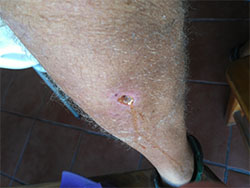 |
| The "Hueco" |
GG was was bringing up the rear of our little group of five, including the guide, when I slipped on some mud, went down and punched a "hueco" (small hole) in my right leg on a sharp rock. That action also introduced mud into the wound, which I now understand to have been laden with bacteria. When I showed the picture of the hueco (right) to a Tico friend of mine he said: "Looks like the kind of bullet hole you get when you're trying to steal chickens, Bob."
We were about half way around the tour circuit, the one that the tour operator had earlier described as the least challenging of two he had to offer, when the accident occurred. A friend on the tour, known locally by many as Carlos-Charlie, who had driven us up the mountain in his 4x4, helped me go back to the base camp safely then helped me clean up and bandage the wound. He also got to use the basic Red Cross skills he perfected over several years as a lifeguard. Thanks much for your help Charlie.
Later in the afternoon we stopped by the emergency room at the hospital where they cleaned the wound and re-bandaged it. That was Wednesday, February 28 and I thought no more of it but by the following Monday the whole leg was swollen and red and I visited the emergency room again. They cleaned it and bandaged it again. Little change occurred and I went back again a couple of days later for the third time. This time a cautious emergency room doctor didn't like the story of me being there three times and ordered some extensive blood tests which I waited on for several hours. At the end he came to me and announced I would be a guest of the hospital for 4-5 days, that the infection would need intensive care. In reality it would turn out to require six days.
 |
| Nothing Like Hospital Rest |
That's when my regular care doctor got involved and ordered an intensive (every 8 hours) IV of two different antibiotics. That and endless interruptions for temperature, blood pressure, pulse, EKG and a myriad of other monitoring and testing probes resulted in very little sleep during that period; my estimate is 10-15 hours over six days. But the swelling slowly went down until it was a simple red ring around the wound shown in the photo above, yet it still was somewhat infected. When I got out of the hospital I had three more appointments (doc, blood test, wound-cleaning people) for three days after.
At the next appointment I was introduced to a young lady, Maryanne by name, who did another cleaning but this time she really dug out the nasties (ouch). Mayanne works in the Curaciones department (basically, outpatient services that are not part of the emergency room). She put me on a frequent visitor list and the wound is getting better slowly (holes in your leg don't close easily).
I can now see that I underestimated the difficulty in overcoming this kind of infection. I've always enjoyed a quick recovery from things like this due to a strong immune system, but in this case it's a combination of age and diabetes (GG is Type II). The jungle here is intensely beautiful but it's good to remember that it also houses some pretty nasty critters including strong bacteria.
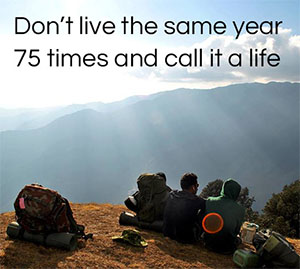 |
Answer to Que Es Eso?
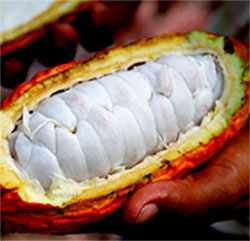
This is a ripe, cacao pod grown in tropical regions including Costa Rica. That's cacao or cah-cow not cocoa.
These are the seeds that are processed into cocoa but, even more importantly, into chocolate.
To see in more detail how chocolate is made, go here: Cacao
Etymology of Casado
Casado is the name of a typical meal platter mentioned in the section on food and markets in the GGU article above.
The word comes from casar, to marry and casado is the past participle - married. Very appropriate to the nature of the dish as explained above. Of course, if you are a female, you are casada not casado.
de la Finca - Quepos
Location: Across the street from Banco Popular (or 100 meters north of Super 2000 and on the other side of the street)
Hours: Mon-Fri: Lunch/Dinner (Open at 12 PM); Saturday: Dinner Only (Open at 4 PM), Closed Sunday
Parking: Several places in front of the restaurant plus across the street during dinner hours.
Contact: Telephone Reservations: 8644-9082; facebook page: Facebook
Reviewing ROMEOS: Alma L., Anita M. Bob N., Glen N., Jerry C., Joanne K., Julia S., Lorenzo
To Review Our Rating System and Procedure, go here: R.O.M.E.O. Rating System
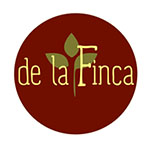
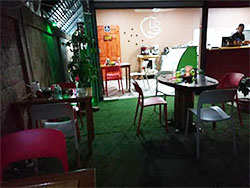 |
| de la Finca Dining Room |
This is a new restaurant formed by a couple of cuisine professionals with long experience in cheffing and service including for a well-known restaurant at the Quepos Marina. The dining room is small, intimate (especially if you occupy most of it as we did) and warm. It was a pleasant surprise to find such a place off the beaten track in downtown Quepos.
We had made a reservation and were able to be seated together at the dining room's largest table, a pleasant heavy wood structure of local derivation and construction I would guess. Once seated, the feeling of being on a downtown street in Quepos disappeared.
The group gave de la Finca a composite score of 3.3/5.0 for ambiance.
The menu offered was not extensive but included a selection of ribs, steaks, fish, a couple of Thai dishes as well as several combinations of wraps. Within our group just about every item except the steaks was ordered. Most items were reported as well prepared, well presented and tasty.
The ribs, previously touted by GG, who had had them at a previous experience at de la Finca, were, unfortunately, less consistent and more fatty than before.
GG chose Tuna steak medallions in a light Thai-spiced sauce. Served with a medley of vegetables and small boiled potatoes on a skewer, the dish was excellent in presentation and flavor.
Postres (desserts) were limited to a maracuya (passion fruit) cheesecake which was tasty and well presented but not of the rich consistency expected with cheesecake.
The group gave de la Finca a composite score for food quality of 3.9/5.0. |
 |
|---|---|
| $$$.2 | |
Value Index= 122 |
The group was served by Ramiro, a pleasant and helpful gent who was attentive and helpful. The group composite score for service came in as the highest of all three categories at 4.4/5.0. That gave a composite average for ambiance, food quality and service of 3.9 sloths.
GG's bill for a naturale drink (maracuya with mint), the Thai Tuna, the cheesecake and a coke was almost exactly 15,000 colones (about $27), quite reasonable for the quality and quantity of food presented. Other ROMEOs reported reasonable check amounts.
The composite score for cost for all eight ROMEOs came in at $3.2 yielding a value index of 3.9/3.2x100=122 putting de la Finca in the top of 1/3 of values in our list.
The ROMEO Group can recommend de la Finca for a good meal in a pleasant atmosphere at an above average value.
¡Pura Vida!
The Golden Gringo Chronicles is a free newsletter that is non-political, non-commercial and, hopefully, entertaining. By signing up you will receive an email each month around the first of the month giving you the links to the latest edition as well as to each individual feature and departmental section.
CLICK HERE TO SIGN-UP FOR THE
GOLDEN GRINGO CHRONICLES
or Email me at gg@goldengringo.com, and see our Website at: www.goldengringo.com

Bob Normand, Editor & The Golden Gringo
Pura Vida!
To Contact GGC World Headquarters (yuk, yuk) to make comments, suggest topics or criticize my bad jokes, just send an email to: gg@goldengringo.com.
Be pithy but kind; I'm sensitive. (center)
Unsubscribe from Golden Gringo Chronicles